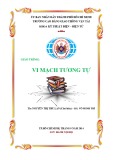
CAN THO JOURNAL OF SCIENCE AND TECHNOLOGY - No.05 February, 2025
22
HUMAN RESOURCE TRAINING FOR THE SEMICONDUCTOR
INDUSTRY IN DIGITAL TRANSFORMATION:
NEEDS AND CHALLENGES
Hang Sam Nang
1
, Dang Thi Dung
2
, and Bui Xuan Tung
3
1 Mien Tay Construction University
2 Can Tho University of Technology
3 Tay Do University
Email: dtdung@ctuet.edu.vn
ARTICLE INFO
Received: 25/10/2024
Revised: 17/02/2025
Accepted: 19/02/2025
Keywords: Digital
transformation, semiconductor
design, human resource
training, high-tech industry,
workforce development,
educational collaboration.
ABSTRACT
The development of the semiconductor industry is becoming a
significant revolution to promote the country's growth and enhance
its global standing. Vietnam currently holds a valuable opportunity
to integrate more deeply into the global semiconductor supply chain
by fostering collaborations with multinational corporations,
investing in advanced manufacturing capabilities, and enhancing
workforce training to meet global standards. These steps are pivotal
to leveraging Vietnam's potential as a competitive player in the
industry. With an annual growth rate of 7-9%, semiconductor chips
are regarded as the foundation of modern computing and play a
critical role as the world advances into an era of burgeoning
research and the application of emerging technologies like AI, IoT,
5G, and Big Data.
The demand for materials and technology during the digital
transformation process includes sensor systems, the Internet of
Things (IoT), Artificial Intelligence of Things (AIoT), broadband
communication, high-speed computing, and more. These
technologies are necessary for data collection, storage, processing,
and analysis, forming the backbone of digital communication
networks and supporting the evolution of a digital society.
Applications of Fourth Industrial Revolution technologies will be
implemented in fields such as industrial production monitoring,
remote control of agricultural processes, education, and more to
foster digital transformation across multiple sectors.
1. INTRODUCTION
Semiconductors, or "chips," are vital
components powering the advanced digital
devices integral to modern life. From
smartphones and pacemakers to the internet,
airplanes, and hypersonic weapons,
semiconductors are integral to nearly every
industry. They play a central role in economic
growth, security, and technological
innovation, driving advancements in
communication, healthcare, military systems,
transportation, clean energy, and many other
applications (Morris, 1990).
The semiconductor industry plays a vital
role in shaping and driving the development
of various sectors in the global economy,
contributing over $620 billion in revenue as of
2024, with projections to reach $1 trillion by
2030. It underpins advancements in key
industries such as telecommunications, clean

CAN THO JOURNAL OF SCIENCE AND TECHNOLOGY - No.05 - February, 2025
23
energy, healthcare, and transportation, making
it a cornerstone of modern innovation. As one
of the backbone industries for economic
growth, it provides the foundation for other
fields like electricity, electronics, automation,
and telecommunications. Often referred to as
the "lifeline" of the digital economy,
semiconductors are pivotal and are projected
to generate over $620 billion in revenue by
2024, escalating to $1 trillion by 2030. This
industry also forms the core of the
technological competition among global
powers in the 21st century (Chung, 2021).
According to the Industrial Policy and
Strategy Research Institute, 2024 marks the
first year of Vietnam's national strategy for
developing the semiconductor industry. This
foundational and critical sector is expected to
remain a national priority for the next 30-50
years, presenting Vietnam with a chance to
bolster its domestic electronics industry.
Vietnam's rapidly growing economy has
achieved significant milestones and
accomplishments. In the semiconductor
sector, numerous collaboration agreements
and investment projects have emerged. For
instance, Intel has expanded phase two of its
chip testing factory in Ho Chi Minh City with
a total investment of $4 billion. Amkor
Semiconductor plans to inaugurate its factory
in Bac Ninh in October 2023, with an
investment of approximately $1.6 billion.
Most recently, on September 16, 2023, Hana
Micron (South Korea) opened its
semiconductor manufacturing facility in the
Van Trung Industrial Park (Bac Giang),
marking the first semiconductor production
project in northern Vietnam. The company
aims to achieve $300 million in revenue this
year and plans to increase its total investment
to over $1 billion by 2025, generating $800
million in revenue and creating approximately
4,000 jobs (Anh V., 2024).
Aligned with global trends, Associate
Professor Dr. Tran Xuan Tu, Director of the
Institute of Information Technology at
Vietnam National University, Hanoi,
emphasized that Vietnam has a young and
abundant workforce with strong mathematical
thinking capabilities. The country’s pool of
highly skilled talent continues to grow. Fields
like IT, automation, electronics, and computer
engineering all related to different stages of
the semiconductor industry are garnering
substantial interest from the younger
generation. Domestic educational institutions
need to develop comprehensive training plans
to further enhance workforce quality and
leverage this advantage.
Semiconductors, chip design, and related
fields have garnered considerable attention
from various nations. Experts and managers
worldwide recently convened to discuss these
topics at the "SEMI SEA TalentConnect"
forum. This event, organized by the Global
Semiconductor Industry Association (SEMI)
in collaboration with Vietnam National
University, Hanoi, was a part of the 2023
Vietnam Business Summit. The forum aimed
to connect talent, offering Vietnamese
students and youth a deeper understanding of
the semiconductor industry in Southeast Asia
and globally. Discussions also focused on
opportunities for collaboration between SEMI
and Vietnamese universities to develop
human resources in semiconductor chip
design. Mr. Scott Nguyen, Director of
Customer Support at Kulicke & Soffa,
remarked, "We are surrounded by
semiconductors. These tiny chips power
everything from mobile phones to cars. It can
be said that semiconductors play a crucial role
in shaping the world" (Minh, 2023).
According to Tuan (2023), within
Vietnam's semiconductor market, power
management integrated circuits (PMICs)
dominate with a market share of
approximately 68%, followed by microchips
at 29%, while the remaining segment is
attributed to radio-frequency identification
(RFID) technology. The revenue of PMICs

CAN THO JOURNAL OF SCIENCE AND TECHNOLOGY - No.05 February, 2025
24
and microchips is projected to grow by 40%
between 2020 and 2025
From an application perspective, consumer
electronics lead with a market share of around
62%, followed by information and
communication technology (ICT) at 21%, and
the automotive sector at approximately 10%.
The ICT product market size is expected to
grow by 45% during 2020–2025, while
consumer electronics and automotive
segments are anticipated to expand by 32%
over the same period (Tuan, 2023).
Figure 1. Projected Growth Rate of Semiconductor Product Segments
Source: Tuan, (2023).
Information Technology (IT) would not
exist without microchips. Over a decade ago,
mobile phones and computers were
considered luxury items in Vietnam,
accessible only to a small demographic with
substantial economic means. Today,
technology has become an indispensable part
of life. From university students and high
schoolers to primary school children, owning
a mobile phone or laptop is almost ubiquitous.
Even preschoolers are familiar with iPads and
smartphones, adeptly using them as a part of
their natural development. This
transformation illustrates that technology has
evolved beyond being a mere tool; it has
become a fundamental factor reshaping the
way we live and work. Businesses of all sizes
rely on computers for data processing and
operations management. Technology has
permeated both domestic life and
revolutionized core industrial sectors,
transforming everything from manufacturing
facilities to service providers, educational
institutions to communication networks. The
semiconductor revolution has not only
broadened access to information and

CAN THO JOURNAL OF SCIENCE AND TECHNOLOGY - No.05 - February, 2025
25
knowledge but has also created a connected
society where people can learn and grow.
While the aforementioned points highlight
the impact of semiconductors on the
electronics industry, this influence extends
across various other industries. Today,
virtually every modern industrial product
contains semiconductors. In critical products
like smartphones and automobiles, the value
of semiconductors constitutes an increasingly
significant proportion of the overall product
cost. For instance, a smartphone typically
contains around 20 chips, accounting for 60%
of its total value. In luxury cars, the number of
chips required is estimated to be ten times that
of a smartphone (KH&CN, 2023), resulting in
a far higher chip value proportion for high-
end vehicles than ever before. Moreover, as
discussed earlier, the emergence of
semiconductors has made IT a reality,
revolutionizing economic, cultural, and social
activities on a global scale
2. LITERATURE REVIEW
Globally, the semiconductor industry is
projected to face a labor shortage of 70,000 to
90,000 workers in the United States over the
coming years. In Japan, the Semiconductor
Industry Association forecasts an annual
deficit of approximately 1,000 high-quality
personnel over the next decade. This shortage
is further exacerbated by Japan's “race” to
establish new semiconductor manufacturing
facilities, which demands an increasingly
skilled workforce. To address this challenge,
the South Korean Ministry of Education has
launched a “10-year roadmap” aimed at
training 150,000 semiconductor graduates.
Selected universities are being designated as
“semiconductor universities,” with each
region establishing dedicated semiconductor
research centers integrated into a national
network (Anh V., 2024).
During the 2024 “Semiconductor Day”
event held on August 30 at the Ariyana
International Convention Center in Da Nang,
Deputy Minister of Information and
Communications Bui Hoang Phuong
emphasized that the Internet of Things (IoT)
and Artificial Intelligence (AI) are core
technologies of the Fourth Industrial
Revolution (Industry 4.0). At the heart of IoT
and AI are semiconductor chips.
Semiconductor technology is embedded in
almost all devices and facets of daily life,
shaping and redefining the world with
profound impacts on economic and national
security. Developing the semiconductor
industry must be coupled with advancements
in the electronics sector to create sustainable
markets for semiconductor chips. Vietnam
should also focus on building a highly skilled
workforce to position itself as a global human
resource hub for the semiconductor industry
(TT&TT, 2024)
According to Nguyen (2023), the growing
demand for skilled labor in the semiconductor
technology sector has made it an attractive
field in the 2024 university admissions cycle.
The Ministry of Information and
Communications reported that Vietnam
requires 5,000 to 10,000 semiconductor
engineers annually, yet current output meets
less than 20% of this demand. Data from the
National Portal on Science and Technology
reveals that Vietnam currently has 5,575 chip
design engineers. Economic experts forecast
that over the next five years, the demand for
semiconductor professionals will rise to
20,000, and to 50,000 within the next decade
(KH&CN, 2023). Developing the workforce
requires a collaborative effort between the
government, academia, and industry. This
tripartite partnership helps students gain
practical experience in chip design and testing
while learning to address technical challenges
in production processes. Training programs at
Vietnam National University, Hanoi; Vietnam
National University, Ho Chi Minh City; and
FPT University, in collaboration with industry

CAN THO JOURNAL OF SCIENCE AND TECHNOLOGY - No.05 February, 2025
26
partners, are actively contributing to creating
an environment conducive to talent
development in this field.
Vietnam's semiconductor industry is
experiencing a significant growth, attracting
numerous large-scale projects. Approximately
80% of enterprises in the sector focus on
final-stage chip design, leveraging low
investment costs and simplified training
requirements. However, the majority of these
designs are outsourced to foreign partners,
accounting for over 80% of the industry's total
value. Despite the growing number of
enterprises, Vietnam's contribution to the
global value chain remains modest, primarily
limited to assembly, testing, and packaging
stages segments dominated by major
corporations such as Samsung, Intel, and
Foxconn (Dai Nam University, 2024)
According to research conducted by Long
and Linh (2024), Vietnam currently has over
5,500 chip design engineers, with more than
76% based in Ho Chi Minh City. Workforce
projections indicate that by 2030, Vietnam will
require approximately 15,000 engineers for
chip design and 35,000 personnel for
production, testing, and packaging stages.
However, current capacity is estimated to meet
only about 20% of this demand (Figure 2).
Figure 2. Estimated Number of Chip
Design Engineers in Vietnam 2000–2021
Source: Yen, (2021).
The advancement of digital transformation
necessitates the development of systems such
as sensors, the Internet of Things (IoT),
Artificial Intelligence of Things (AIoT),
broadband communication, and high-speed
computing. These systems are essential for
collecting, storing, accumulating, processing,
and analyzing data, forming the foundation
for implementing digital communication
networks. Such technologies support the
functionality of a digital society, enabling
remote monitoring, control, and inspection of
activities related to industrial and agricultural
production, among others. These applications
leverage the technologies of the Fourth
Industrial Revolution.
From Figure 3, it is evident that testing
(27.5%) and physical design (16.8%)
represent the largest proportions of workforce
demand, underscoring the critical need for
specialized talent in these fields.
In the face of significant opportunities for
the country, the Government has promptly
recognized emerging trends and leveraged its
role through diplomatic channels and the
implementation of policy tools to attract
investors. However, one of the major concerns
for investors is the readiness of Vietnam's
workforce in the semiconductor sector, both
in terms of quantity and quality.
Regarding the workforce, Minister of
Information and Communications - Nguyễn
Mạnh Hùng stated in a working session with
the two national universities on September 6,
2023, Vietnam needs 10,000 engineers
annually to meet the labor demand for the
semiconductor industry. However, the current
supply meets less than 20% of this need
(KH&CN, 2023). In reality, the
semiconductor industry must compete for
talent with other rapidly developing high-tech
sectors such as electronics, automation,
artificial intelligence, and more.
According to a survey conducted by the
Institute of Economic and Business Policy
(IBEP), approximately 60% of universities
across the country offer programs that support
the semiconductor sector, such as Information



![Giáo trình Vi mạch tương tự (Phần 2): CĐ Giao thông Vận tải [Mới nhất]](https://cdn.tailieu.vn/images/document/thumbnail/2021/20210708/bautroimaudo/135x160/1952838099.jpg)

![Giáo trình Vi mạch số: Phần 2 - CĐ Giao thông Vận tải [Tài liệu đầy đủ]](https://cdn.tailieu.vn/images/document/thumbnail/2021/20210708/bautroimaudo/135x160/1078090755.jpg)
![Giáo trình Vi mạch số lập trình (Điện tử công nghiệp) - CĐ Công nghiệp và Thương mại [Mới nhất]](https://cdn.tailieu.vn/images/document/thumbnail/2021/20210601/ermintrudetran/135x160/9681622516104.jpg)

















![Bài giảng Tổ chức - Cấu trúc Máy tính II Đại học Công nghệ Thông tin (2022) [Mới Nhất]](https://cdn.tailieu.vn/images/document/thumbnail/2025/20250515/hoatrongguong03/135x160/8531747304537.jpg)

